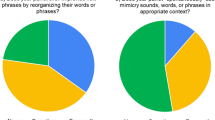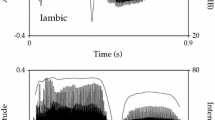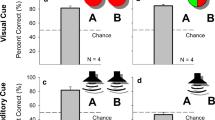Abstract
There is little evidence of vocal learning in nonhuman primates despite the well-documented abilities found in avian species. We describe the vocal repertoire of five bonobos (Pan paniscus), four of which live in a seminatural environment. The fifth subject, Kanzi, has been reared with humans during the course of language training. The data indicated that the four bonobos living in a seminatural environment exhibit a variety of species-typical vocalizations. In addition to producing all the species-typical vocalization, Kanzi produced four structurally unique vocalizations that were not heard among the other subjects. These data suggest that Kanzi has learned vocalizations that are novel due to his unique rearing experience. Discussion is focused on the flexibility of vocal communication and vocal comprehension inPan paniscus.
Similar content being viewed by others
References
Aitken, P. G., and Wilson, W. A. (1979) Discriminative vocal conditioning on rhesus monkeys: Evidence of volitional control?Brain Language 8: 227–240.
Bates, E. (1979)The Emergence of Symbols: Cognition and Communication in Infancy, Academic Press, New York.
Bruner, J. (1975). Nature and uses of immaturity.Am. Psychol. 8: 687–708.
Chomsky, N. (1968).Language and Mind, Harcourt Brace Jovanovich, New York.
De Waal, F. (1988) The communicative repertoire of captive bonobos (Pan paniscus) compared to that of chimpanzees,Behaviour 106: 183–251.
De Waal, F. (1990). Behavioral contrast between bonobo and chimpanzee. In Heltne, P. G., and Marquardt, L. A. (eds.),Understanding Chimpanzees, Harvard University Press, Cambridge, MA, pp. 154–176.
Furness, W. H. (1916). Observations on the mentality in chimpanzees and orang-utans.Proc. Am. Phil. Soc., 55: 281–290.
Gardner, R. A., and Gardner, B. T. (1968). Teaching sign language to a chimpanzee.Science 165: 664–672.
Gautier, J. P. (1974). Field and laboratory studies of the vocalization of talapoin monkeys (Miopithecus talapoin).Behaviour 51: 209–273.
Gouzoules, S., Gouzoules, H., and Marler, P. (1984). Rhesus monkey (Macaca mulatta) screams: Representational signalling in the recruitment of agonistic aid.Anim. Behav. 32: 182–193.
Hauser, M. (1989). Ontogenetic changes in the comprehension and production of vervet monkey (Cercopithecus aethiops) vocalizations.J. Comp. Psychol. 103: 149–158.
Hayes, K. J. (1951).The Ape in Our House, Harper, New York.
Lancaster, J. (1969) Primate communication systems and the emergence of human language. In Jay, P. (ed.),Primates: Studies in Adaptation and Variability, Holt, Rinehart, & Winston, New York, pp. 267–290.
Lawick-Goodall, J. van. (1968). A preliminary report on expressive movements and communication in the Gombe Stream chimpanzees. In Jay, P. C. (ed.),Primates, Holt, Rinehart & Winston, New York, pp. 318–378.
Lieberman, P. (1975).On the Origins of Language, Macmillan, New York.
Lieberman, P., Crelin, E. S., and Klatt, D. H. (1972) Phonetic ability and related anatomy of the new born, adult human, Neandrathal man, and the chimpanzee.Am. Anthropol. 74: 287–307.
Marler, P. (1965). Communication in monkeys and apes. In Devore, I. (ed.),Primate Behavior, Holt, Rinehart & Winston, New York, pp. 432–465.
Marler, P., (1976) An ethological theory of the origin of vocal learning.Ann. N. Y. Acad. Sci. 280: 386–396.
Masataka, N., and Fujita, K. (1989) Vocal learning of Japanese and rhesus monkeys.Behaviour 4: 191–199.
Mori, A. (1984). Comparison of the communicative vocalizations and behaviors of group ranging in Eastern gorillas, chimpanzees and bonobos.Primates 24: 486–500.
Newman, J. D., and Symmes, D. (1973) Vocal pathology in socially deprived monkeys.Dev. Psychobiol. 7: 351–358.
Patterson, F. G. (1978). The gestures of a gorilla: Language acquisition in another pongoid.Brain Language 5: 72–97.
Premack, D. (1970). A functional analysis of langauge.J. Exp. Anal. Behav. 14: 107–125.
Rumbaugh, D. M. (1977).Language Learning by a Chimpanzee: The LANA Project, Academic Press, New York.
Savage-Rumbaugh, E. S. (1986).Ape Language: From Conditioned Response to Symbols, Columbia University Press, New York.
Savage-Rumbaugh, E. S. (1987) Communication, symbolic communication and language: Reply to Seidenberg and Petitto.J. Exp. Psychol. Gen. 116: 288–292.
Savage-Rumbaugh, E. S. (1988). A new look at ape language: Comprehension of vocal speech and syntax.Nebraska Symp. Motivat. 35: 201–256.
Savage-Rumbaugh, E. S., McDonald, K., Sevcik, R. A., Hopkins, W. D., and Rubert, E. (1986). Spontaneous symbol acquisition and communicative use by pygmy chimpanzees (Pan paniscus).J. Exp. Psychol. Gen. 115: 1–22.
Savage-Rumbaugh, E. S., Romski, M. A., Hopkins, W. D., and Sevcik, R. A. (1990). Symbol acquisition and use byPan troglodytes, Pan paniscus, Homo sapiens. In Heltne, P. G. and Marquardt L. A. (eds.),Understanding Chimpanzees, Harvard University Press, Cambridge MA, pp. 266–296.
Seyfarth, R. M., and Cheney, D. L. (1986) Vocal development in vervet monkeys.Anim. Behav. 34: 1640–1658.
Seyfarth, R. M., and Cheney, D. L. (1990). Meaning, reference, intentionality in the natural vocalizations in monkeys. Paper presented at the. XIIIth Congress of the International Primatological Society, Kyoto, Japan, July.
Seyfarth, R. M., Cheney, D. L., and Marler, P. (1980a). Vervet monkey alarm calls: Semantic communication in a free ranging primate.Anim. Behav. 28: 1070–1094.
Seyfarth, R. W., Cheney, D. L., and Marler, P. (1980b). Monkey responses to three different alarm calls: Evidence of predator classification and semantic communication.Science 210: 801–803.
Snowdown, C. T. (1982). Linguistic and psycholinguistic approaches to primate communication. In Snowdown, C. T., Brown, C. H., and Peterson, M. R. (eds.),Primate Communication, Cambridge University Press, New York, pp. 212–238.
Sinnott, J. M., Stebbins, W. C., and Moody, D. B. (1975). Regulation of voice amplitude by the monkey.J. Acoust. Soc. Am. 58: 412–414.
Struhsaker, T. T. (1967). Auditory communication among vervet monkeys (Cercopithecus aethiops). In Altmann, S. A. (ed.),Social Communication, Among Primates, University of Chicago Press, Chicago, pp. 281–324.
Sutton, D., Larson, C., Taylor, E. M., and Lindeman, R. C. (1973). Vocalization in the rhesus monkey: Conditionability.Brain Res. 52: 225–231.
Winter, P., Handley, P., Ploog, D., and Schott, D. (1973). Ontogeny of squirrel monkey vocalizations under normal conditions and under acoustic isolation.Behaviour 47: 230–239.
Yerkes, R. M., and Yerkes, A. M. (1929).The Great Apes: A Study of Anthropoid Life, Yale University Press, New Haven, CT.
Author information
Authors and Affiliations
Rights and permissions
About this article
Cite this article
Hopkins, W.D., Savage-Rumbaugh, E.S. Vocal communication as a function of differential rearing experiences inPan paniscus: A preliminary report. International Journal of Primatology 12, 559–583 (1991). https://doi.org/10.1007/BF02547670
Received:
Accepted:
Issue Date:
DOI: https://doi.org/10.1007/BF02547670




